Abstract
Staphylococcal enterotoxin B was treated with 0.15 or 0.3% formaldehyde at 37 C and pH 7.3. As early as 8 hr after addition of HCHO, the toxin was unable to precipitate as much antibody from antiserum as untreated toxin; greater amounts of treated toxin were required to reach equivalence and to inhibit precipitation. With increasing time, its reactivity decreased so that at 32 weeks it could precipitate only 20% as much antibody as untreated toxin. When other factors were kept constant, the degree of inactivation increased as the HCHO concentration increased from 0.6 to 1.4%. Treated toxin gave a “reaction of partial identity” by the Ouchterlony double-immunodiffusion technique. The emetic effect of the toxin for the monkey remained essentially unchanged for about 48 hr of treatment, but the amount required to cause death by the intravenous route increased from 25 to over 1,000 μg/kg of body weight. HCHO destroyed the pyrogenic effect for rabbits. The treated toxin remained immunogenic for rabbits even after 4 to 5 weeks of exposure to 0.3% HCHO at 37 C.
Full text
PDF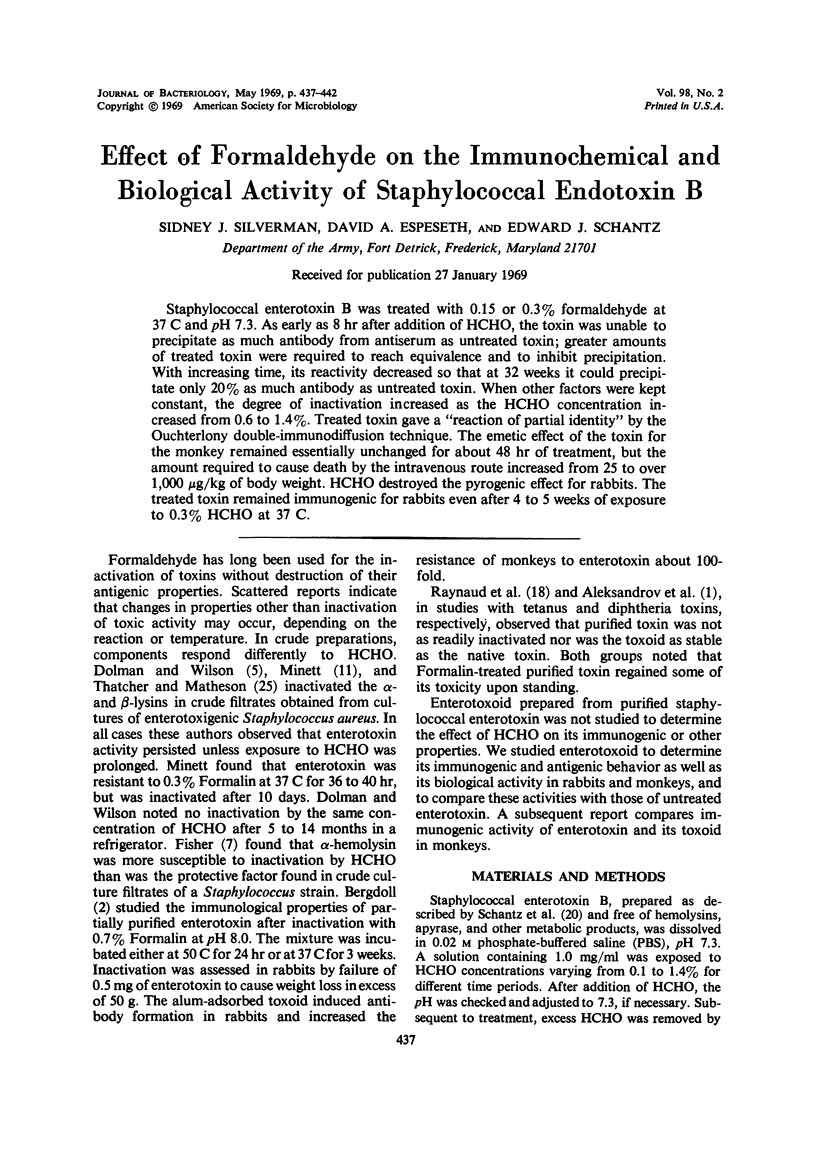
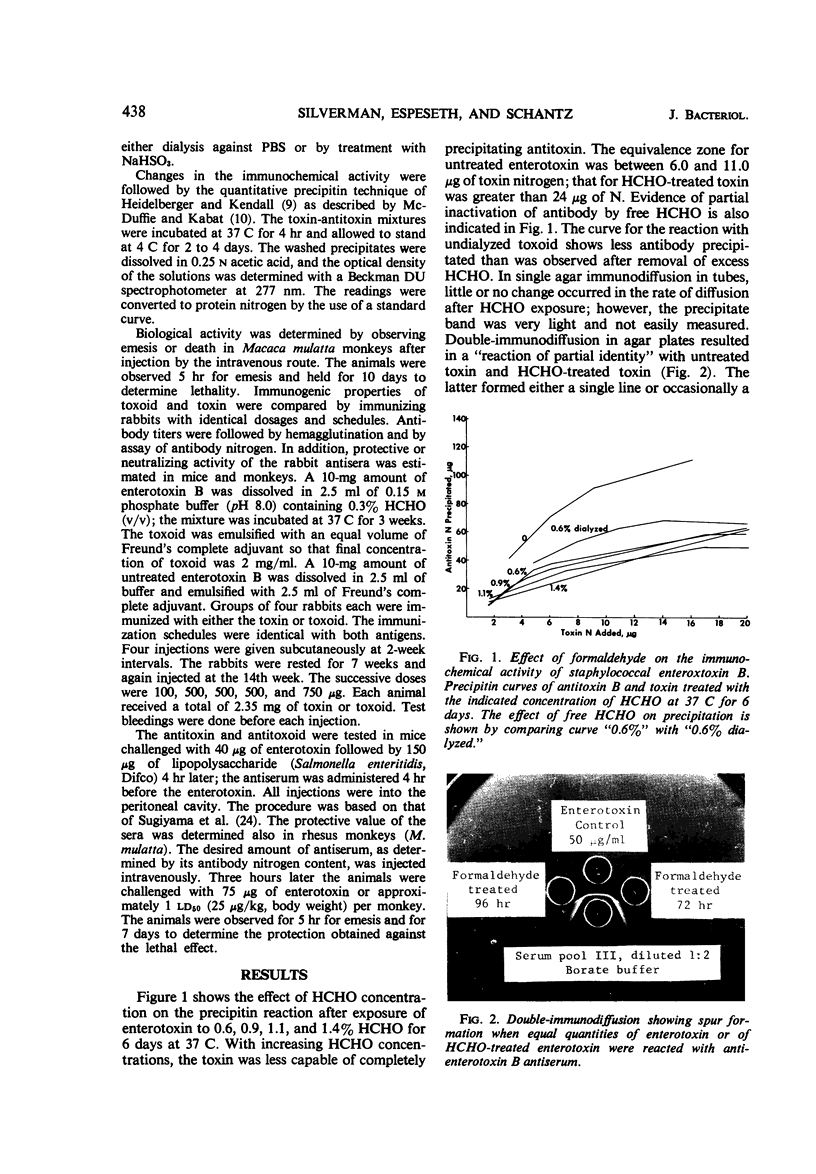

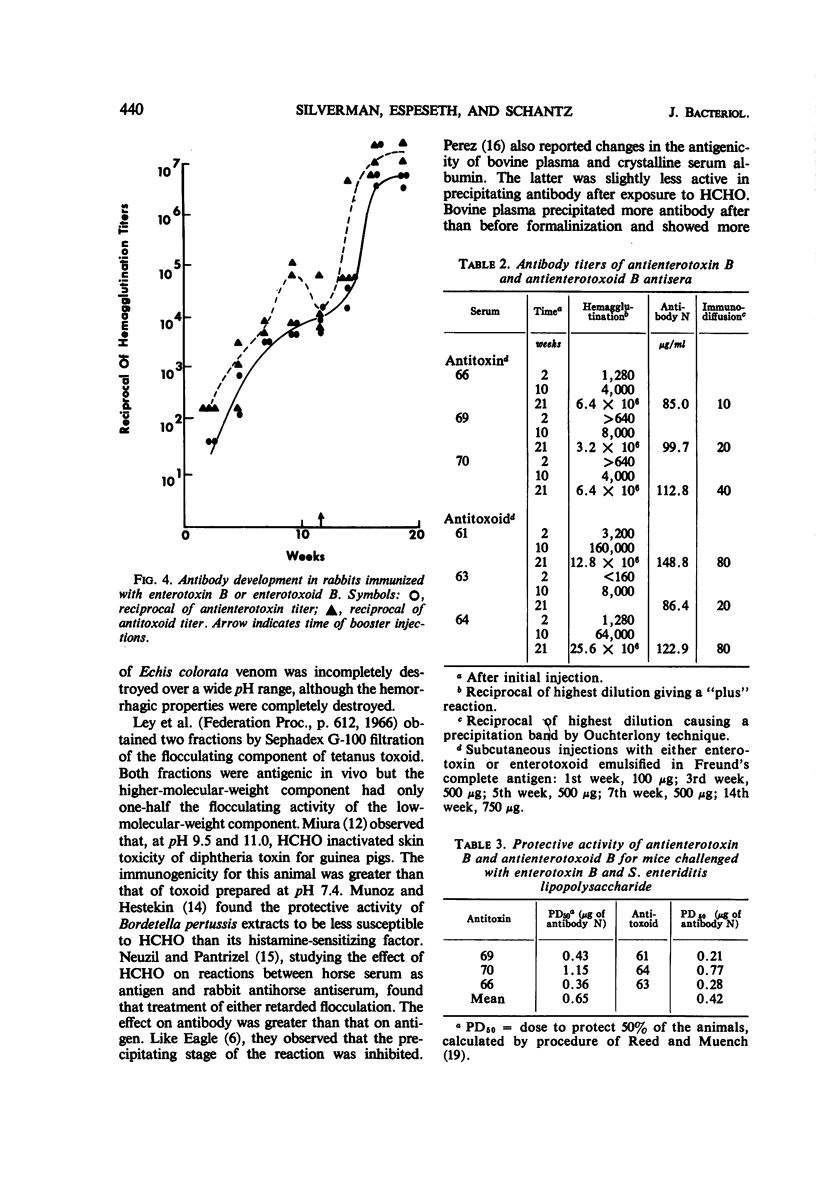
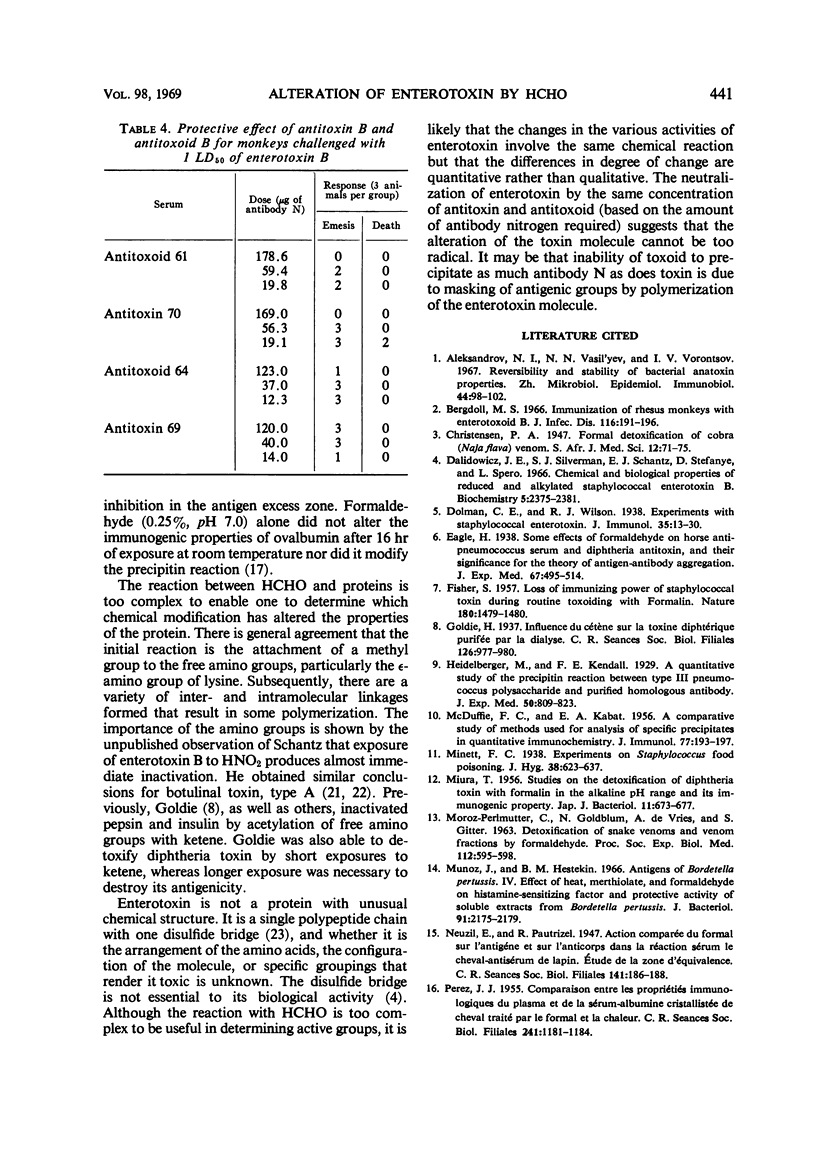
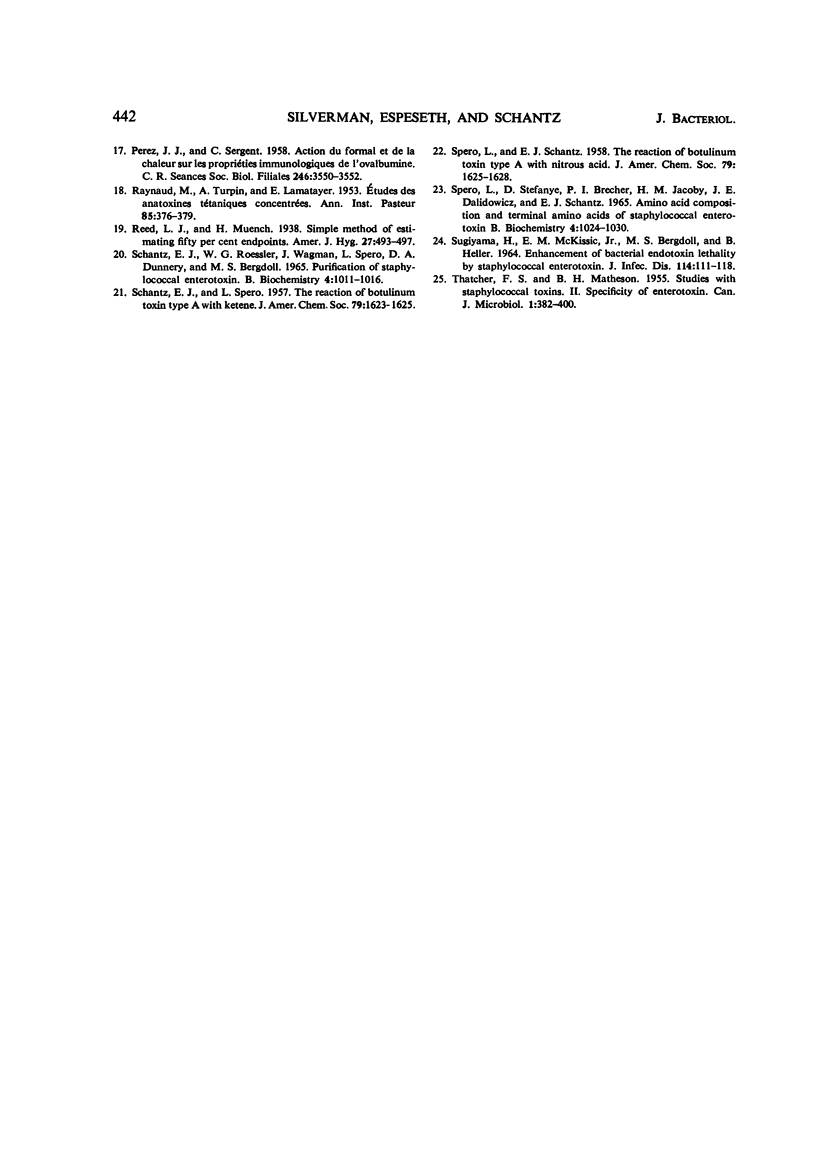
Images in this article
Selected References
These references are in PubMed. This may not be the complete list of references from this article.
- Bergdoll M. S. Immunization of Rhesus monkeys with enterotoxoid B. J Infect Dis. 1966 Apr;116(2):191–196. doi: 10.1093/infdis/116.2.191. [DOI] [PubMed] [Google Scholar]
- Dalidowicz J. E., Silverman S. J., Schantz E. J., Stefanye D., Spero L. Chemical and biological properties of reduced and alkylated staphylococcal enterotoxin B. Biochemistry. 1966 Jul;5(7):2375–2381. doi: 10.1021/bi00871a029. [DOI] [PubMed] [Google Scholar]
- FISHER S. Loss of immunizing power of staphylococcal toxin during routine toxoiding with formalin. Nature. 1957 Dec 28;180(4600):1479–1480. doi: 10.1038/1801479b0. [DOI] [PubMed] [Google Scholar]
- KABAT E. A., MCDUFFIE F. C. A comparative study of methods used for analysis of specific precipitates in quantitative immunochemistry. J Immunol. 1956 Sep;77(3):193–197. [PubMed] [Google Scholar]
- Munoz J., Hestekin B. M. Antigens of Bordetella pertussis. IV. Effect of heat, merthiolate, and formaldehyde on histamine-sensitizing factor and protective activity of soluble extracts from Bordetella pertussi.s. J Bacteriol. 1966 Jun;91(6):2175–2179. doi: 10.1128/jb.91.6.2175-2179.1966. [DOI] [PMC free article] [PubMed] [Google Scholar]
- PEREZ J. J. Comparaison entre les propriétés immunologiques du plasma et de la sérum-albumine cristallisée de cheval traités par le formol et la chaleur. C R Hebd Seances Acad Sci. 1955 Oct 24;241(17):1181–1184. [PubMed] [Google Scholar]
- PEREZ J. J., SERGENT C. Action du formol et de la chaleur sur les propriétés immunologiques de l'ovalbumine. C R Hebd Seances Acad Sci. 1958 Jun 23;246(25):3550–3552. [PubMed] [Google Scholar]
- RAYNAUD M., TURPIN A., LEMETAYER E. Etude des anatoxines tétaniques concentrées. Ann Inst Pasteur (Paris) 1953 Sep;85(3):376–379. [PubMed] [Google Scholar]
- SUGIYAMA H., MCKISSIC E. M., Jr, BERGDOLL M. S., HELLER B. ENHANCEMENT OF BACTERIAL ENDOTOXIN LETHALITY BY STAPHYLOCOCCAL ENTEROTOXIN. J Infect Dis. 1964 Apr;114:111–118. doi: 10.1093/infdis/114.2.111. [DOI] [PubMed] [Google Scholar]
- Schantz E. J., Roessler W. G., Wagman J., Spero L., Dunnery D. A., Bergdoll M. S. Purification of staphylococcal enterotoxin B. Biochemistry. 1965 Jun;4(6):1011–1016. doi: 10.1021/bi00882a005. [DOI] [PubMed] [Google Scholar]
- Spero L., Stefanye D., Brecher P. I., Jacoby H. M., Dalidowicz J. E., Schantz E. J. Amino acid composition and terminal amino acids of staphylococcal enterotoxin B. Biochemistry. 1965 Jun;4(6):1024–1030. doi: 10.1021/bi00882a007. [DOI] [PubMed] [Google Scholar]
- THATCHER F. S., MATHESON B. H. Studies with staphylococcal toxins. II. The specificity of enterotoxin. Can J Microbiol. 1955 Jun;1(6):382–400. doi: 10.1139/m55-050. [DOI] [PubMed] [Google Scholar]



